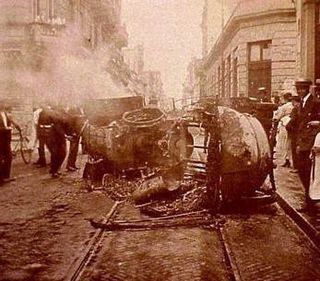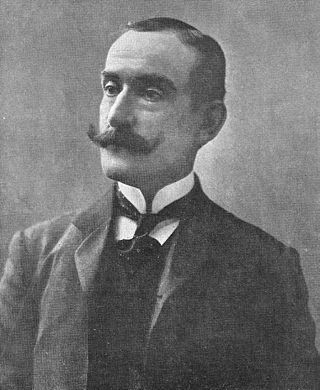
La Recoleta Cemetery is a cemetery located in the Recoleta neighbourhood of Buenos Aires, Argentina. It contains the graves of notable people, including Eva Perón, presidents of Argentina, Nobel Prize winners, the founder of the Argentine Navy, and military commanders such as Julio Argentino Roca. In 2011, the BBC hailed it as one of the world's best cemeteries, and in 2013, CNN listed it among the 10 most beautiful cemeteries in the world.

San Luis is a province of Argentina located near the geographical center of the country. Neighboring provinces are, from the north clockwise, La Rioja, Córdoba, La Pampa, Mendoza and San Juan.

A rent strike is a method of protest commonly employed against large landlords. In a rent strike, a group of tenants come together and agree to refuse to pay their rent en masse until a specific list of demands is met by the landlord. This can be a useful tactic of final resort for use against intransigent landlords, but carries the risk of eviction and lowered credit scores in some cases.

The Primera Junta or Junta Provisional Gubernativa de las Provincias del Río de la Plata, is the most common name given to the first government of what would eventually become Argentina. It was formed on 25 May 1810, as a result of the events of the May Revolution. The Junta initially only had representatives from Buenos Aires. When it was expanded, as expected, with the addition of representatives from the other cities of the Viceroyalty of the Río de la Plata, it became popularly known instead as the Junta Grande or Junta Provisional Gubernativa de Buenos Aires. The Junta operated at El Fuerte, which had been used since 1776 as a residence by the viceroys.

The Infamous Decade was a period in Argentine history that began with the 1930 coup d'état against President Hipólito Yrigoyen. This decade was marked on one hand by significant rural exodus, with many small rural landowners ruined by the Great Depression, which in turn pushed the country towards import substitution industrialization, and on the other hand, by electoral fraud to perpetuate conservative governments in power. The poor results of economic policies and popular discontent led to another coup in 1943, the Revolution of 1943, by the Grupo de Oficiales Unidos (GOU), a nationalist faction of the Armed Forces, which triggered the rise to power of Juan Perón.

Mecha Ortiz was a classic Argentine actress who appeared in films between 1937 and 1981, during the Golden Age of Argentine Cinema. At the 1944 Argentine Film Critics Association Awards, Ortiz won the Silver Condor Award for Best Actress for her performance in Safo, historia de una pasión (1943), and won it again in 1946 for her performance in El canto del cisne (1945). She was known as the Argentine Greta Garbo and for playing mysterious characters, who suffered by past misfortunes in love, mental disorders, or forbidden love. Safo, historia de una pasión was the first erotic Argentine film, though there was no nudity. She also played in the first film in which a woman struck a man and the first film with a lesbian romance. In 1981, she was awarded the Grand Prize for actresses from the National Endowment for the Arts.

Laura Ana "Tita" Merello was an Argentine film actress, tango dancer and singer of the Golden Age of Argentine Cinema (1940–1960). In her six decades in Argentine entertainment, at the time of her death, she had filmed over thirty movies, premiered twenty plays, had nine television appearances, completed three radio series and had had countless appearances in print media. She was one of the singers who emerged in the 1920s along with Azucena Maizani, Libertad Lamarque, Ada Falcón, and Rosita Quiroga, who created the female voices of tango. She was primarily remembered for the songs "Se dice de mí" and "La milonga y yo".

Osvaldo Bayer was an Argentine writer and journalist. He lived in Buenos Aires. In 1974, during the presidency of Isabel Perón, he went into exile, residing in Linz am Rhein, Germany, throughout the National Reorganization Process dictatorship (1976–1983).

Tragic Week, also known as Bloody Week, was a series of riots and massacres that took place in Buenos Aires, Argentina, from January 7 to 14, 1919. The uprising was led by anarchists and communists and was eventually crushed by the Argentine Federal Police, the military, and the Argentine Patriotic League. Estimates of the death toll vary but are usually in the hundreds, mostly of workers at the hands of the government forces.

The Argentina Bicentennial was a series of ceremonies, festivals, and observances celebrated on May 25, 2010, and throughout the year. They commemorated the 200th anniversary of the May Revolution, a sequence of historical events that led to the Viceroy Baltasar Hidalgo de Cisneros being ousted from office and replaced with the Primera Junta, the first national government.

Patagonia Rebelde was the name given to the uprising and violent suppression of a rural workers' strike in the Argentine province of Santa Cruz in Patagonia between 1920 and 1922. The uprising was put down by Colonel Héctor Benigno Varela's 10th Cavalry Regiment of the Argentine Army under the orders of President Hipólito Yrigoyen. Approximately 300-1,500 rural workers were shot and killed by the 10th Cavalry Regiment in the course of the operations, many of them executed by firing squads after surrendering. Most of the executed were Spanish and Chilean workers who had sought refuge in Argentina's Patagonia after their strike in the city of Puerto Natales in southern Chile in 1919 was crushed by the Chilean authorities, at the cost of four carabiniers killed and the offices of their union were burned by the civilians, policemen and the militaries in Punta Arenas on July 27, 1920 At least two Argentine soldiers, three local policemen and a number of ranch owners and their relatives also died during the strife. According to the versions well publicized by the army and the landowners, several of the captured women were raped in the uprising as the rebel forces fought for control of the territory. These versions have been widely discredited. The most detailed narrative of these events is that by Osvaldo Bayer, summarized in English by Bruce Chatwin in 1976.

Jumbo is a Chilean hypermarket chain with a presence in Chile, Argentina, and Colombia. Founded in 1976 by Horst Paulmann, Jumbo is a subsidiary and pillar of the Cencosud business consortium, which also owns Santa Isabel, Disco, Super Vea, and Metro supermarkets, as well as Easy and Paris stores.

Ramón Lorenzo Falcón was an Argentine Army officer, politician, and Chief of the Argentine Federal Police.

Olinda Bozán was an Argentine film actress and comedian of the Golden Age of Argentine Cinema (1940–1960). Born into a circus family, she acted on the vaudeville circuit, and performed in silent and sound movies. She was trained by the Podestá brothers, one of whom she married, who have one of the most prestigious Argentine acting awards named for them. Bozán' appeared in 75 films and was considered one of the best comic actors of Argentine cinema in the 20th century.
Omar Acha is an Argentine historian and political essayist. He is a researcher at the Consejo Nacional de Investigaciones Científicas y Técnicas and also at the Centro de Investigaciones Filosóficas (Argentina). He teaches Philosophy of History at the Universidad de Buenos Aires. He was also a member of the editorial board of Herramienta. Revista de Teoría y Crítica Marxista, published in Buenos Aires.
Ernestina A. López de Nelson (1879–1965) was an Argentine educator and women's rights activist who served as Argentina's representative to the Inter-American Commission of Women from its founding in 1928 into the 1940s. She was the first woman in Argentina to earn a doctorate of letters and was a founder of the Argentine Association of University Women.

The anarchist movement in Chile emerged from European immigrants, followers of Mikhail Bakunin affiliated with the International Workingmen's Association, who contacted Manuel Chinchilla, a Spaniard living in Iquique. Their influence could be perceived at first within the labour unions of typographers, painters, builders and sailors. During the first decades of the 20th century, anarchism had a significant influence on the labour movement and intellectual circles of Chile. Some of the most prominent Chilean anarchists were: the poet Carlos Pezoa Véliz, the professor Dr Juan Gandulfo, the syndicalist workers Luis Olea, Magno Espinoza, Alejandro Escobar y Carballo, Ángela Muñoz Arancibia, Juan Chamorro, Armando Triviño and Ernesto Miranda, the teacher Flora Sanhueza, and the writers José Domingo Gómez Rojas, Fernando Santiván, José Santos González Vera and Manuel Rojas. At the moment, anarchist groups are experiencing a comeback in Chile through various student collectives, affinity groups, community and cultural centres, and squatting.
The 2020 COVID-19 pandemic in Argentina affected the human rights situation in the country.
The Friends of the Earth was an urban guerrilla group from Buenos Aires, known for perpetrating arson attacks against public and private vehicles.
The Sociedad Cosmopolita de Resistencia y Colocación de Obreros Panaderos was a trade union for bakers in Argentina. It was founded in 1887 by Italian anarchist labor organizer Ettore Mattei.

















